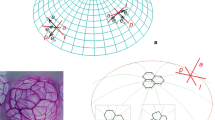Abstract
A determined division wall positioning in each plant cell with respect to the last formed division wall leads to autoreproductive configurations which can simulate plant-like meristems as such with 2/5 phyllotactic patterns. L-map systems are used to generate the corresponding topological wall nets. But in these patterns cells are not six-sided as mostly found in layers. It is shown that wall staggering cannot be a determinate device of the cell itself, nor a randomized dissociation of the cross walls, but results from a physical control with interaction between adjacent cells. It is independent of the cellular program responsible for the appearance of patterns like 2/5 phyllotaxis which is of a pentameric nature.
Résumé
Dans les assises cellulaires des végétaux, les cellules ont en moyenne six côtés et à chaque noeud convergent trois parois. Les figures en croix sont rares. Les parois de division de deux cellules voisines ont des points d'ancrage qui s'évitent en formant un décrochement. Le court segment de paroi ainsi introduit compte comme paroi cellulaire quand on détermine la distribution du nombre de côté ou de voisins des cellules.
Les ‘map-systems’ à récriture parallèle permettent de générer des réseaux 2D correspondant aux parois cellulaires. La supposition d'un ancrage déterminé des parois de division avec une position fixe par rapport à la plus jeune des parois d'une cellule permet de simuler l'émergence et l'arrangement spatio-temporel des protubérances foliaires dans une phylllotaxie 2/5. Partant axiomatiquement d'une différenciation de 5 côtés des cellules, la construction se réalise au cours du développement par des cellules à 5, 4 et 3 côtés. Il s'en suit que la majorité des noeuds du réseau pariétal sont des convergences de degré 4.
Pour dissocier les croix en deux convergences de trois parois, diverses stratégies sont essayées. Ni un décalage systématique dans une direction donnée, ni un sens aléatoire des décalages ne conduisent aux distributions du degré polygonal des cellules autour de six. Un système à interactions cellulaires est capable de déterminer le site et le sens des dislocations de façon à tendre, topologiquement, vers un pavage d'hexagones. Biologiquement cela signifierait que l'organisation du tissu, bâti dans le cas de la phylloyaxie 2/5 sur une structure pentamérique, est indépendante d'un contrôle physique assurant le pavage par des cellules hexagonales.
Il est suggéré, en partant d'épidermes d'apex végétaux réels, et en supprimant les décalages entre ancrages de parois de division voisines, de rechercher le système de développement simple capable de générer l'image de l'organisation tissulaire sous-jacente à une morphologie complexe.
Similar content being viewed by others
References
Baluška, F., J.S. Parker and P.W. Barlow (1992). Specific patterns of cortical and endoplasmic microtubules associated with cell growth and tissue differentiation in roots of maize (Zea mays L.). J. of Cell Sci. 103: 191–200.
Barlow, P.W. (1991). From cell wall networks to algorithms. Protoplasma 162: 69–85.
Boer, M.J.M. de, and A. Lindenmayer (1987). Map OL-systems with edge label control: Comparison of marker and cyclic systems. In: H. Ehrig, M. Nagl, G. Rozenberg & A. Rosenfeld, eds., Graph Grammars and their Application to Computer Science. Berlin, Springer-Vlg., Lect. Notes in Computer Science, 291: 378–392.
Dormer, K.J. (1980). Fundamental Tissue Ggeometry for Biologists. Cambridge University Press.
Douady, S. and Y. Couder (1992). Phys. Rev. Lett. 68: 2098–2101.
Green, P.B. (1985). Surface of the shoot apex: a reinforcement-field theory for phyllotaxis. J. Cell Sci. Suppl. 2: 181–201.
Hellendoorn, P.H. and A. Lindenmayer (1974). Phyllotaxis in Bryophyllum tubiflorum: morphogenetic studies and computer simulations. Acta Bot. Neerl. 23: 473–492.
Lück, H.B. and J. Lück (1987a). From map systems to plant morphogenesis. In: E. Teramoto & M. Yamaguti, eds., Mathematical Topics in Population Biology, Morphogenesis and Neurosciences. Berlin, Springer-Vlg., Lect. Notes in Biomathematics 71: 199–208.
Lück, H.B. and J. Lück (1987b). Modélisation du fonctionnement d'un méristème par des L-systèmes et des systèmes de graphes et de cartes à réécriture parallèle. In: H. Le Guyader, ed., Développement des Végétaux, Aspects Théoriques et Synthétiques, Paris, Masson. Collection Biologie théorique 2: 375–395.
Lück, J., A. Lindenmayer and H.B. Lück (1988). Models of cell tetrads and clones in meristematic cell layers. Bot. Gaz. 149: 127–141.
Lück, J. and H.B. Lück (1981). Proposition d'une typologie de l'organisation cellulaire des tissus végétaux. In: H. Le Guyader et Th. Moulin, eds., Actes 1er Sém. de l'Ecole de Biol. théor., CNRS. Paris, ENSTA: 335–371.
Lück, J. and Lück, H.B. (1985). Un mécanisme générateur d'hélices phyllotaxiques. In: G. Benchetrit & J. Demongeot, eds., Actes 4ème Sém. de l'Ecole de Biologie théorique du CNRS, Paris, Ed. CNRS: 317–330.
Lück, J. and H.B. Lück (1987c). Vers une nouvelle théorie des méristèmes apicaux des végétaux. In: H.B. Lück, ed., Biologie théorique, Solignac 1985, Paris, Ed. CNRS: 197–213.
Lück, J. and H.B. Lück (1987d). From OL and IL map systems to indeterminate and determinate growth in plant morphogenesis. In: H. Ehrig, M. Nagl, G. Rozenberg & A. Rosenfeld, eds., Graph Grammars and their Application to Computer Science. Berlin, Springer-Vlg., Lect. Notes in Computer Science 291: 393–410.
Nakielski, J. (1991). Distribution of linear growth rates in different directions in root apical meristems. Acta Soc. Bot. Poloniae 60: 77–86.
Prusinkiewicz, P. (1987). Applications of L-systems to computer imagery. In: H. Ehrig, M. Nagl, G. Rozenberg & A. Rosenfeld, eds., Graph Grammars and their Application to Computer Science. Berlin, Springer-Vlg., Lect. Notes in Computer Science 291: 534–548.
Rozenberg, G. and A. Salomaa (1980). The Mathematical Theory of L-Systems. New York, Academic Press.
Author information
Authors and Affiliations
Rights and permissions
About this article
Cite this article
Lück, J., Lück, H.B. Plant cell assemblage in layers. Acta Biotheor 43, 95–111 (1995). https://doi.org/10.1007/BF00709436
Issue Date:
DOI: https://doi.org/10.1007/BF00709436




